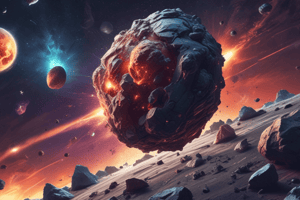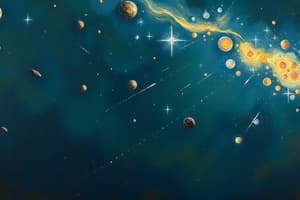Podcast
Questions and Answers
What is the composition of C-type asteroids?
What is the composition of C-type asteroids?
- Clay and silicate rocks (correct)
- Metallic iron and nickel
- Water ice and organic compounds
- Carbon dioxide and methane
Who discovered the first asteroid in 1801?
Who discovered the first asteroid in 1801?
- Isaac Newton
- Galileo Galilei
- Johannes Kepler
- Giuseppe Piazzi (correct)
What is the size range of asteroids?
What is the size range of asteroids?
- Tens of kilometers to hundreds of kilometers wide
- Less than one meter to tens of meters wide
- Less than one kilometer to hundreds of kilometers wide (correct)
- Hundreds of kilometers to thousands of kilometers wide
What is the shape of the first discovered asteroid, Ceres?
What is the shape of the first discovered asteroid, Ceres?
How many types of asteroids are there based on their composition and color?
How many types of asteroids are there based on their composition and color?
What is the main difference between a meteor and a comet?
What is the main difference between a meteor and a comet?
What happens to debris in the tail of a comet when Earth moves through its path?
What happens to debris in the tail of a comet when Earth moves through its path?
What is the primary impact of meteors on Earth?
What is the primary impact of meteors on Earth?
How do asteroids differ from meteors in terms of impact?
How do asteroids differ from meteors in terms of impact?
What would be the most dangerous part of a comet impact on Earth?
What would be the most dangerous part of a comet impact on Earth?
What are S-type asteroids made of?
What are S-type asteroids made of?
Where are most asteroids located?
Where are most asteroids located?
What happens when meteoroids enter Earth's atmosphere?
What happens when meteoroids enter Earth's atmosphere?
What are comets believed to originate from?
What are comets believed to originate from?
What distinguishes asteroids from comets and meteors?
What distinguishes asteroids from comets and meteors?
Flashcards are hidden until you start studying
Study Notes
Asteroids, Meteors, and Comets: Key Facts
- S-type asteroids are made of nickel-iron and silicate materials and appear bright, while M-type asteroids are composed of nickel-iron, with some having volcanic lava on their surface.
- Most asteroids are located in the asteroid belt between Mars and Jupiter, believed to be leftover rock fragments from the solar system's formation.
- Near-Earth asteroids sometimes cross into Earth's orbit, and Trojans are asteroids that orbit planets.
- Asteroids orbit the sun in varying distances and shapes, with some being pulled toward larger bodies like Mars or Jupiter during orbit.
- Meteors are rocks from space that enter Earth's atmosphere, producing a fireball known as a shooting star.
- Meteors range in size from a spec of dust to the size of an asteroid and are typically made of rocks, metal, or a combination of the two.
- Meteors can originate from asteroids, comets, other planets, or the moon, with some meteor showers originating from comets.
- When meteoroids enter Earth's atmosphere, they become meteors, and those that reach the ground are called meteorites.
- Comets are remnants of the solar system's formation, made of dust, rocks, and ice, and release gases as they heat up near the sun.
- Comets range in size from a few miles to tens of miles wide and are believed to originate from the Oort Cloud or the Kuiper Belt.
- Long-period comets take over 200 years to orbit the sun and originate from the Oort Cloud, while short-period comets take less than 200 years and originate from the Kuiper Belt.
- Asteroids are solid rock and metal objects, while comets release gases to create a head and tail, and meteors are pieces of rock and other space objects that burn up in Earth's atmosphere.
Studying That Suits You
Use AI to generate personalized quizzes and flashcards to suit your learning preferences.




